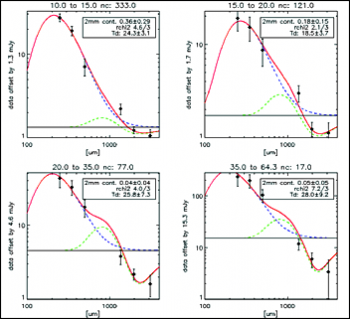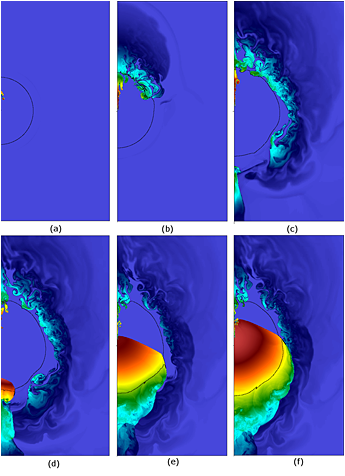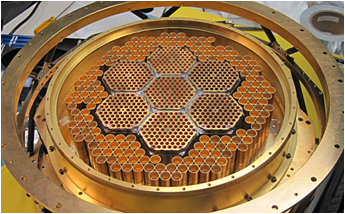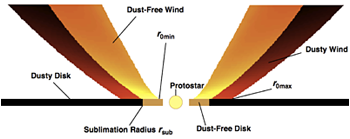 |
 |
 |
 |
 |
 |
 |
 |
 |
 |
|
KICP Workshops & Events
|
PhD Thesis Defenses, 2013 Matthew Becker: "CALCLENS: Weak Lensing Simulations for Large-Area Sky Surveys and Second-Order Effects in Cosmic Shear Power Spectra" May 16, 2013 | 11:00 AM | ACC 211  PhD Committee members: Daniel Holz, John Carlstrom, C. Chin. "Matt's thesis work, in which he has developed a novel algorithm of computing distorsions of galaxy images using data from cosmological simulations, significantly advances our ability to make realistic theoretical predictions for upcoming wide area surveys aiming to map matter distribution in the universe on large scales." - Andrey Kravtsov, PhD advisor Thesis Abstract: I present a new algorithm, CALCLENS, for efficiently computing weak gravitational lensing shear signals from large N-body light cone simulations over a curved sky. This new algorithm properly accounts for the sky curvature and boundary conditions, is able to produce redshift- dependent shear signals including corrections to the Born approximation by using multiple- plane ray tracing, and properly computes the lensed images of source galaxies in the light cone. The key feature of this algorithm is a new, computationally efficient Poisson solver for the sphere that combines spherical harmonic transform and multigrid methods. As a result, large areas of sky (~10,000 square degrees) can be ray traced efficiently at high-resolution using only a few hundred cores. Using this new algorithm and curved-sky calculations that only use a slower but more accurate spherical harmonic transform Poisson solver, I study the convergence, shear E-mode, shear B-mode and rotation mode power spectra. Employing full-sky E/B-mode decompositions, I confirm that the numerically computed shear B-mode and rotation mode power spectra are equal at high accuracy (~1%) as expected from perturbation theory up to second order. Coupled with realistic galaxy populations placed in large N-body light cone simulations, this new algorithm is ideally suited for the construction of synthetic weak lensing shear catalogs to be used to test for systematic effects in data analysis procedures for upcoming large-area sky surveys. The implementation presented in this work, written in C and employing widely available software libraries to maintain portability, is publicly available at http://code.google.com/p/calclens. Related Links: KICP Members: John E. Carlstrom; Daniel E. Holz; Andrey V. Kravtsov KICP Students: Matthew Becker Lindsey Bleem: "A Multi-Wavelength Study of Optically Selected Galaxy Clusters from the Blanco Cosmology Survey" May 28, 2013 | 3:00 PM | LASR conference room  PhD Committee members: Stephan S. Meyer, Michael D. Gladders, Andrey V. Kravtsov, M. Gardel. "After making critical contributions to every aspect of the 10m South Pole Telescope (SPT) program, from testing the initial detectors at Chicago, optimizing the performance of the telescope at the South Pole, analyzing the cosmic microwave background data and leading the optical follow up observations and analysis, Lindsey's thesis has taken the first major step in the joint analysis of the SPT and optical survey data sets. This work thoroughly explores the Sunyaev-Zel'dovich signal of an optical selected sample of galaxy clusters, laying the groundwork and identifying the challenges for obtaining precision dark energy constraints from the much anticipated joint analysis of the SPT data with the upcoming optical data from the Dark Energy Survey." - John Carlstrom, PhD advisor Thesis Abstract: Abundance measurements of galaxy clusters provide powerful constraints of cosmology. The observed distribution of clusters can be used to disentangle whether the accelerated cosmic expansion can be explained by a modification to Einstein's theory of gravity or whether the explanation involves a new form of 'dark' energy. Such growth of structure measurements are both complimentary to and provide an important cross-check of geometrical measurements of the universe. There are two key requirements for cosmology with galaxy clusters: a census of these systems through cosmic time and the ability to connect the measured signal with the underlying mass of the galaxy cluster. In this era of large-area millimeter and optical wavelength surveys (including the South Pole Telescope (SPT) 2500 deg^2 SZ-Survey and the Dark Energy Survey (DES)) where hundreds (mm-wave) to hundreds of thousands (optical) of clusters will be detected, the most serious limitation to cluster cosmology remains creating a well-understood observable-mass relation. Combining cluster observables across wavelengths can both test and inform our knowledge of such scaling relations. As a pilot program for future explorations of the combined SPT and DES datasets, we explore the relation between the optical-richness, λ, and SZ-signal for a sample of 567 optically-selected clusters from the Blanco Cosmology Survey, an ∼ 80 deg^2 survey located within the SPT-SZ survey. In this study we detect SZ-signal at increasing significance as a function of cluster richness but find that the recovered signal falls below expectations derived from models based on X-Ray samples. We explore possible biases to our recovered signal and find that contamination from cluster members - in particular radio and dust emission from galaxies - is small and that the majority of the discrepancy at the high mass end can be explained by poor selection of the optical centers of clusters. Work to improve our centering algorithm is ongoing. The toolset developed here can be combined with future cluster catalogs from the Dark Energy Survey to help improve mass-richness scaling relations and ultimately constrain cosmological models. Related Links: KICP Members: John E. Carlstrom; Michael D. Gladders; Andrey V. Kravtsov; Stephan S. Meyer KICP Students: Lindsey E. Bleem Denis Erkal: "Investigating the Physics and Environment of Lyman Limit Systems in Cosmological Simulations" May 31, 2013 | 10:00 AM | LASR conference room  PhD Committee members: Stephan Meyer, Daniel Holz, Thomas Witten. "In his thesis Denis Erkal has modelled circumgalactic gas using state of the art cosmological simulations and compared model results with existing observations. Such comparisons provide unique and valuable information about how galaxies have assembled their baryonic mass and stellar feedback processes that accompany this assembly." - Andrey Kravtsov, PhD advisor Related Links: KICP Members: Nickolay Y. Gnedin; Daniel E. Holz; Andrey V. Kravtsov; Stephan S. Meyer KICP Students: Denis Erkal Christopher Williams: "A Search For Microwave Emission From Cosmic Ray Air Showers" June 25, 2013 | 2:00 PM | LASR conference room  PhD Committee members: Angela Olinto, Scott Wakely, Sidney Nagel. "The unsolved mystery of ultra-high energy cosmic rays demands a novel approach to the detection of these very rare particles. Chris - a natural-born experimentalist - has made an outstanding contribution with his thesis, by exploring the potential of microwave emission from extensive air showers through a series of careful and accurate measurements. He brought to life MIDAS, an exploratory detector currently taking data at the Pierre Auger Observatory in Argentina, and MAYBE, an electron beam experiment at the Argonne National Laboratory. Measurements performed by these instruments are the most precise of a world-wide campaign to detect microwave emission from cosmic rays." - Paolo Privitera, PhD advisor Thesis Abstract: At the highest energies, the sources of cosmic rays should be among the most powerful extragalactic accelerators. Large observatories have revealed a flux suppression above a few 10^19 eV, similar to the expected effect of the interaction of ultrahigh energy cosmic rays (UHECR) with the cosmic microwave background. The Pierre Auger Observatory has measured the largest sample of cosmic ray induced extensive air showers (EAS) at the highest energies leading to a precise measurement of the energy spectrum, hints of spatial anisotropy, and a surprising change in the chemical composition at the highest energies. To answer the question of the origin of UHECRs a larger sample of high quality data will be required to reach a statistically significant result. One of the possible techniques suggested to achieve this much larger data sample, in a cost effective way, is ultra-wide field of view microwave telescopes which would operate in an analogous way to the already successful fluorescence detection (FD) technique. Detecting EAS in microwaves could be done with 100% duty cycle and essentially no atmospheric effects. This presents many advantages over the FD which has a 10% duty cycle and requires extensive atmospheric monitoring for calibration. We have pursued both prototype detector designs and improved laboratory measurements, the results of which are reported herein, and published in (Alvarez-Muniz et al., 2013; Alvarez-Muniz et al., 2012a; Williams et al., 2012; Alvarez-Muniz et al., 2013). The Microwave Detection of Air Showers (MIDAS) experiment is the first ultra-wide field of view imaging telescope deployed to detect isotropic microwave emission from EAS. With 61 days of livetime data operating on the University of Chicago campus we were able to set new limits on isotropic microwave emission from extensive air showers. The new limits rule out current laboratory air plasma measurements by more than five sigma. The MIDAS experiment continues to take data installed in Argentina, operating in coincidence with the Pierre Auger Observatory. Using the first 70 days of livetime data combined with a sample of EAS events from the Auger surface detector we are able to set a preliminary limit which is even more stringent than that set with the Chicago data set. Test beam efforts performed at Argonne National Lab, The Microwave Air Yield Beam Experiment (MAYBE), have successfully measured a microwave signal which exhibits linear scaling with energy deposit in a frequency range of 1 GHz to 15 GHz. This measurement has produced strong upper limits on the isotropic emission of microwaves from air plasmas. Related Links: KICP Members: Angela V. Olinto; Paolo Privitera; Scott P. Wakely KICP Students: Christopher Williams Scientific projects: Microwave Detection of Air Showers (MIDAS) Yeunjin Kim: "The effect of the nuclear burning during the deflagration on the final observables in Supernovae type Ia" July 15, 2013 | 11:00 AM | TAAC 67  PhD Committee members: Don Lamb, Joshua Frieman, Fausto Cattaneo Thesis Abstract: A common model of the explosion mechanism of type Ia supernovae is based on a delayed detonation of a white dwarf (WD) in which deflagration precedes detonation. We study one of the delayed detonation models, Gravitationally Confined Detonation (GCD), in two-dimensional simulations, and we discuss a range of the final theoretical observables that can plausibly account for the variety of observed events. Furthermore, we probe the pulsational character of the WD due to the deflagration and its effect on the final observables in one-dimensional studies. Two-dimensional GCD models with different ignition conditions, parametrized by the number of ignition bubbles and their locations relative to the center of the WD, were performed. The initial ignition led to the development of the subsonic burning flame which in turn generated nuclear burning energy from C and O burning. Depending on the unique initial condition, different amount of nuclear burning energy was released during the deflagration, and at large the star detonated as either a Classical GCD or a Pulsationally-assisted GCD. Furthermore, we have shown a correlation between the amount of nuclear burning that occurs during the deflagration phase and the final abundances of intermediate mass elements such as Si-group. Lastly, the distribution of the ejecta during the homologous phase was studied for each model. In addition, we create simplified one-dimensional models that test mainly the effects of the pre-detonation stellar internal velocity profile and the post-detonation velocity of expansion on the production of alpha-particle nuclei, including 56Ni. We observe two distinct post-detonation expansion phases: rarefaction and bulk expansion. Almost all the burning to 56Ni occurs only in the rarefaction phase, and its expansion timescale is influenced by pre-existing flow structure in the star, in particular by the pre-detonation stellar velocity profile. We find that the mass fractions of the alpha-particle nuclei, including 56Ni, are tight functions of the empirical physical parameter den_up/v_down, where den_up is the mass density immediately upstream of the detonation wave front and v_down is the velocity of the flow immediately downstream of the detonation wave front. We conclude that the properties of the pre-existing flow, in particular the internal stellar velocity profile, influence the final isotopic composition of burned matter produced by the detonation. Related Links: KICP Members: Joshua A. Frieman; Donald Q. Lamb; James Truran KICP Students: Yeunjin Kim Abigail Crites: "A Measurement of the Cosmic Microwave Background Polarization with SPTpol" August 30, 2013 | 9:00 AM | LASR conference room  PhD Committee members: Hsiao-Wen Chen, Steve Meyer, Scott Dodelson Thesis Abstract: We present maps of the cosmic microwave background (CMB) polarization at 90 and 150 GHz measured with SPTpol and the first EE and TE CMB power spectrum measurements from SPTpol. We also describe the SPTpol instrument in detail. We discuss the development of the SPTpol camera including the cryogenic design and the transition edge sensor (TES) detectors developed at NIST and Argonne National Laboratory. The goals of the SPTpol project are to exploit the high resolution of the telescope (1 arcminute beam) and the high sensitivity afforded by the 1536 detector camera to measure the E-mode power spectrum of the CMB, characterize the B-mode polarization induced by the gravitational lensing of the primordial E-mode CMB polarization, and to detect or set an upper limit on the level of the B-mode polarization from inflationary gravitational waves. This thesis is a first step toward accomplishing these goals. Related Links: KICP Members: John E. Carlstrom; Hsiao-Wen Chen; Scott Dodelson; Stephan S. Meyer KICP Students: Abigail T. Crites Scientific projects: South Pole Telescope (SPT) Alissa Bans, "Large-scale Magnetic Fields in Protoplanetary Disks" September 26, 2013 | 10:30 AM | TAAC #67  Thesis Abstract: In this talk I will review how large-scale magnetic fields affect protoplanetary accretion disks. I will focus on fields that give rise to magneto-rotationally driven disk-winds, and show how these outflows can lead to unique observational signatures in young stellar objects. I will also discuss how these fields can affect the disk dynamically, particularly how they influence the orbital migration of low-mass planets. Related Links: KICP Members: Michael D. Gladders; Andrey V. Kravtsov; James Truran KICP Students: Alissa Bans |





 Overview
Overview